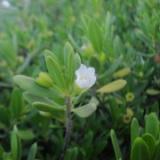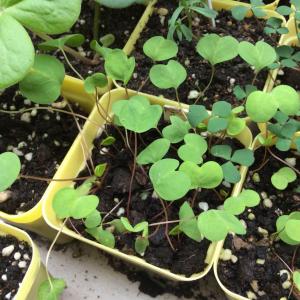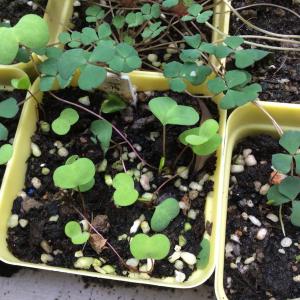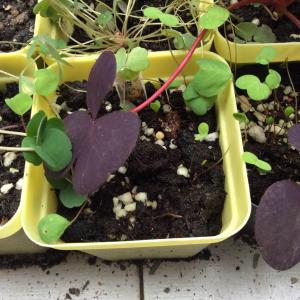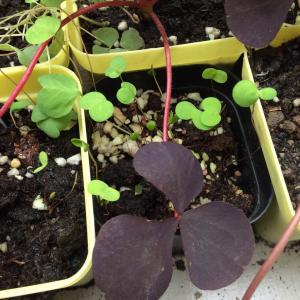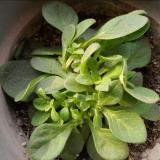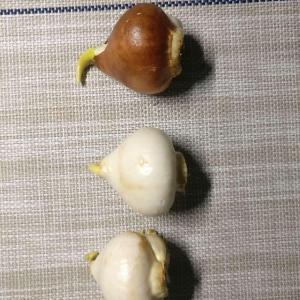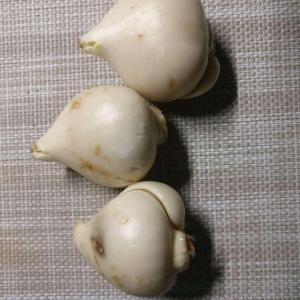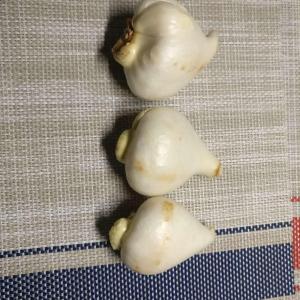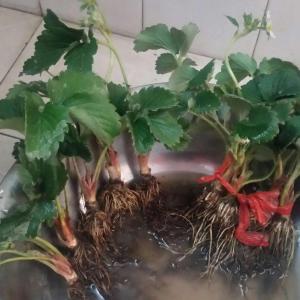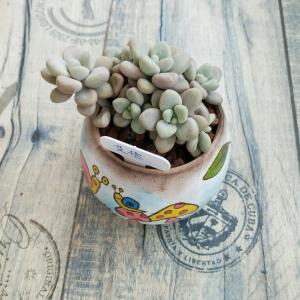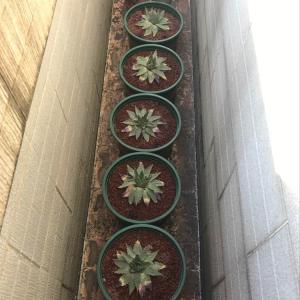文章
Miss Chen
2017年12月23日

Description: This perennial wildflower is 1½–3' tall, consisting of some basal leaves and a flowering stem with alternate leaves. The basal leaves are up to 4" long and 4" across; each basal leaf is palmately divided into 3-5 segments, and each of these segments are subdivided into linear lobes about 3-4 mm. across. The slender petioles of the basal leaves are up to 4" long. The alternate leaves are similar in appearance to the basal leaves, except they become smaller while ascending the stem and their petioles are shorter. The basal leaves, alternate leaves, and the petioles are finely pubescent and whitish green to green. The central stem is terete, short-pubescent, and whitish green; it is unbranched or sparingly branched where the floral racemes occur. The central stem terminates in an elongated raceme of flowers about ½–1' long; sometimes there are 1 or 2 lateral racemes that are shorter. Individual flowers are about 1" long and 1" across; depending on the local ecotype, they vary in color from light blue to deep blue-violet.
Each flower consists of 5 sepals, 4 petals, 3 pistils, and numerous stamens. The petal-like sepals spread outward and they have rounded tips; the base of the uppermost sepal forms the ascending nectar spur, which curves upward. Near the tip of each sepal, there is often a patch of green. The small upper petals form a short hood over the throat of the flower and their bases extend into the nectar spur; they are often more white or light-colored than the lower petals or sepals. The lower petals are cleft and covered with fine woolly hairs; sometimes they are slightly purple. The pedicel of each flower is about 1" long and ascending; it has a pair of tiny linear bracts toward the middle. Near the base of each pedicel, there is a single linear bract that is larger in size and ascending. The blooming period occurs from late spring to early summer and lasts about 3-4 weeks. Each flower lasts about 1 week; several flowers are often in bloom at the same time. Each flower is replaced by a cluster of 3 seedpods (technically, follicles) that are joined together at the base. The individual seedpods are about ½–¾" long, angular in shape, and beaked; they are held erect. Each seedpod splits open along the inner side to release its seeds. The angular seeds are short-oblongoid with appressed scales; they are slightly winged along their margins. The root system is coarsely fibrous. Reproduction is by seed.

Cultivation: The preference is full sun, rather dry conditions, and soil that is rocky or sandy. This wildflower dislikes competition and prefers barren ground where the ground vegetation is sparse. If necessary, it can tolerate a little shade. The basal leaves usually wither away before the flowers bloom, but this is normal.
Range & Habitat: The native Wild Larkspur is restricted to a few counties in western and central Illinois (see Distribution Map); it is uncommon. Two subspecies have been observed in Illinois. One of them, Delphinium carolinianum virescens (Prairie Larkspur), was collected in Hancock County by Dr. Mead during the 19th century; it may be extirpated from the state. The typical subspecies, Delphinium carolinianum carolinianum (Wild Larkspur), has been collected from the remaining counties. Prairie Larkspur is more common in areas to the west of the Mississippi River, while Wild Larkspur is more common in the southeastern and south-central states. Habitats include hill prairies, upland sand prairies, rocky glades, barren savannas, and rocky openings in upland woodlands.

Faunal Associations: Bumblebees suck nectar from the flowers and help to cross-pollinate them. Insects that feed on Delphinium spp. (Larkspurs) include flower-eating larvae of a moth, Heliothis phloxiphagus (Dark-Spotted Straw), leaf-mining larvae of an Agromyzid fly (Phytomyza aconiti), and an aphid (Brachycaudus rociadae). This latter insect sucks sap from the stems and leaves. Because the foliage of Wild Larkspur (Delphinium carolinianum) is more or less toxic to mammalian herbivores, it is usually avoided by them.
Photographic Location: The wildflower garden of the webmaster in Urbana, Illinois.

Comments: The flowers of this species are quite attractive – how unfortunate that it isn't more common! The only other larkspur that is native to Illinois, Delphinium tricorne (Dwarf Larkspur), is found primarily in woodlands in the southern half of the state. This latter species has shorter flowering stalks and leaves with wider lobes (exceeding ¼" across); furthermore, its seed capsules are widely spreading, rather than erect. An annual species from Europe that is grown in gardens, Consolida ajacis (Rocket Larkspur), occasionally escapes into waste areas. This species has leaves with lobes that are nearly filiform (worm-like) and it has only one seed capsule per flower. In contrast, each flower of Wild Larkspur matures into clusters of 3 seed capsules. The typical subspecies of Wild Larkspur, Delphinium carolinianum carolinianum, has been described above. The other subspecies that has been found in Illinois, Delphinium carolinianum virescens (Prairie Larkspur), differs from the typical subspecies as follows: 1) Its flowers tend to be more white (varying from white to light blue), 2) Its basal leaves usually don't wither before the flowers bloom, and 3) Its seeds have projecting scales, while lacking wings along their margins. Sometimes Prairie Larkspur is regarded as a distinct species, in which case it is referred to as Delphinium virescens. Wild Larkspur and Prairie Larkspur occasionally hybridize when they occur together in the same area.
Each flower consists of 5 sepals, 4 petals, 3 pistils, and numerous stamens. The petal-like sepals spread outward and they have rounded tips; the base of the uppermost sepal forms the ascending nectar spur, which curves upward. Near the tip of each sepal, there is often a patch of green. The small upper petals form a short hood over the throat of the flower and their bases extend into the nectar spur; they are often more white or light-colored than the lower petals or sepals. The lower petals are cleft and covered with fine woolly hairs; sometimes they are slightly purple. The pedicel of each flower is about 1" long and ascending; it has a pair of tiny linear bracts toward the middle. Near the base of each pedicel, there is a single linear bract that is larger in size and ascending. The blooming period occurs from late spring to early summer and lasts about 3-4 weeks. Each flower lasts about 1 week; several flowers are often in bloom at the same time. Each flower is replaced by a cluster of 3 seedpods (technically, follicles) that are joined together at the base. The individual seedpods are about ½–¾" long, angular in shape, and beaked; they are held erect. Each seedpod splits open along the inner side to release its seeds. The angular seeds are short-oblongoid with appressed scales; they are slightly winged along their margins. The root system is coarsely fibrous. Reproduction is by seed.

Cultivation: The preference is full sun, rather dry conditions, and soil that is rocky or sandy. This wildflower dislikes competition and prefers barren ground where the ground vegetation is sparse. If necessary, it can tolerate a little shade. The basal leaves usually wither away before the flowers bloom, but this is normal.
Range & Habitat: The native Wild Larkspur is restricted to a few counties in western and central Illinois (see Distribution Map); it is uncommon. Two subspecies have been observed in Illinois. One of them, Delphinium carolinianum virescens (Prairie Larkspur), was collected in Hancock County by Dr. Mead during the 19th century; it may be extirpated from the state. The typical subspecies, Delphinium carolinianum carolinianum (Wild Larkspur), has been collected from the remaining counties. Prairie Larkspur is more common in areas to the west of the Mississippi River, while Wild Larkspur is more common in the southeastern and south-central states. Habitats include hill prairies, upland sand prairies, rocky glades, barren savannas, and rocky openings in upland woodlands.

Faunal Associations: Bumblebees suck nectar from the flowers and help to cross-pollinate them. Insects that feed on Delphinium spp. (Larkspurs) include flower-eating larvae of a moth, Heliothis phloxiphagus (Dark-Spotted Straw), leaf-mining larvae of an Agromyzid fly (Phytomyza aconiti), and an aphid (Brachycaudus rociadae). This latter insect sucks sap from the stems and leaves. Because the foliage of Wild Larkspur (Delphinium carolinianum) is more or less toxic to mammalian herbivores, it is usually avoided by them.
Photographic Location: The wildflower garden of the webmaster in Urbana, Illinois.

Comments: The flowers of this species are quite attractive – how unfortunate that it isn't more common! The only other larkspur that is native to Illinois, Delphinium tricorne (Dwarf Larkspur), is found primarily in woodlands in the southern half of the state. This latter species has shorter flowering stalks and leaves with wider lobes (exceeding ¼" across); furthermore, its seed capsules are widely spreading, rather than erect. An annual species from Europe that is grown in gardens, Consolida ajacis (Rocket Larkspur), occasionally escapes into waste areas. This species has leaves with lobes that are nearly filiform (worm-like) and it has only one seed capsule per flower. In contrast, each flower of Wild Larkspur matures into clusters of 3 seed capsules. The typical subspecies of Wild Larkspur, Delphinium carolinianum carolinianum, has been described above. The other subspecies that has been found in Illinois, Delphinium carolinianum virescens (Prairie Larkspur), differs from the typical subspecies as follows: 1) Its flowers tend to be more white (varying from white to light blue), 2) Its basal leaves usually don't wither before the flowers bloom, and 3) Its seeds have projecting scales, while lacking wings along their margins. Sometimes Prairie Larkspur is regarded as a distinct species, in which case it is referred to as Delphinium virescens. Wild Larkspur and Prairie Larkspur occasionally hybridize when they occur together in the same area.
1
0
文章
家里的二哈爱吃花
2017年12月20日


叶肿病
这种病的确是能让叶子“肿起来”,在春天结束和夏天刚开始的时候最容易发生,如果温度低或者湿度太高的话是很容易出现的。尤其是到了3-5月的时候,平均气温可能到15-20℃,相对湿度也比较高,移到连续阴雨的时候,就很容易发生。如果是长在海拔比较高的地方,发生的概率还要更大。还未发病的时候就需要抓紧防治了,可以在抽梢的时候喷洒波尔多液。一旦发现了病叶,就要立刻摘掉销毁,然后给未发病的植株喷施药剂,在一个月之内喷洒2-3次即可。

叶斑病
这种病刚开始只是在叶面上长出小小的斑点,但是防治不当的话,小斑点会渐渐扩大,严重的话可能蔓延到整个叶片上面,整个叶子都会脱落,所以一定要尽早预防,发现之后要及时治理。遇见已经发病的叶子一定要摘除销毁,因为这类病菌是可以在残体上面越冬的,如果不销毁,第二年还会侵害植株。
一旦已经出现这种情况,处了销毁病株之外,还要还要进行药物防治,每隔10天就要喷一次药,供喷施7-8次就可以了。

币厄病
如果叶片已经受害,叶片的上面会出现一层白色或者红色的质层,主要是由于其他小虫咬伤的位置被细菌感染。同样的,清除掉病叶之后,也要喷洒药物,或者把呋喃丹放在盆子里面也是能够防治这种病发生的。
0
0
文章
Miss Chen
2017年12月19日


孔雀竹芋植株密集丛生挺拔株高20-60厘米。叶柄紫红色, 从根状茎长出,叶片薄革质,卵状椭圆形,长10-20厘米,宽5-10厘米黄绿色,在叶的表面绿色上隐约呈现着一种金属光泽,且明亮艳丽,主脉两侧交互排列,羽状暗绿色长椭形的绒状斑纹,与斑纹相对的叫背面为紫色,左右交互排列。 叶片有 “睡眠运动 , 即在夜间叶片从叶鞘部向上延至叶片,昱抱茎折叠,翌晨阳光照射后重新展。
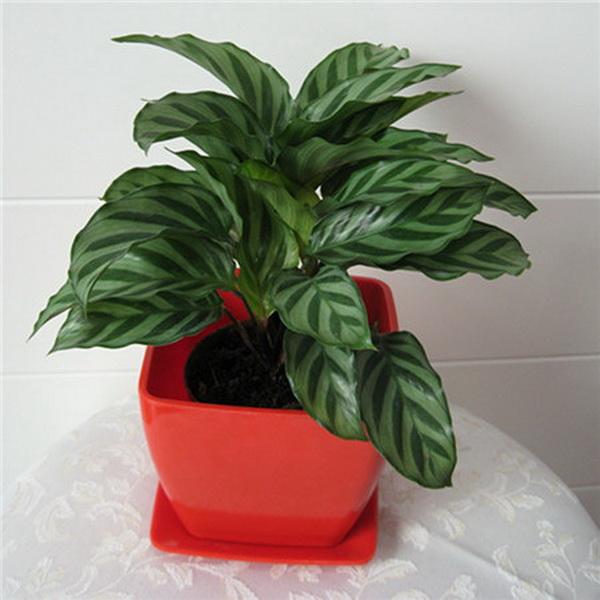
孔雀竹芋适合放在室内养护吗?
孔雀竹芋是放在可以室内的,但是放在室内的话,有优点也有缺点。优点是,孔雀竹芋白天会进行光合作用,提供氧气,美化居室,陶冶情操,并能增加室内空气湿度。但缺点是孔雀竹芋晚上会吸收氧气,与人争二氧化碳,因为孔雀竹芋的株型并不大,其“危害性”并不高。如果觉得不安全,可以放在其他区域,或者晚上将其移出卧室。
孔雀竹芋放在卧室有什么好处
其实家中的植物,大家都会想要了解这种植物是否有毒,孔雀竹芋是大家很喜欢的一种植物,是无毒的,大家可以放心的在家中养护。其实孔雀竹芋净化空气的本领很强大,虽然比不上吊兰,但要比其他的植物高很多,放在卧室内可以清除甲醛以及氨气,这个可比空气净化器方便省心多了。
放在室内养护的植物有什么条件
卧室是大家休息的地方,并不是所有的植物都可以放在卧室,而且有些植物放在卧室长得未必会很好。卧室可以放一下能吸收二氧化碳的植物,比如说盆栽的柑桔、迷迭香、吊兰、斑马叶等,它们香味并不浓烈,不至于被熏得头昏脑涨的。当然像绿萝这样喜水的植物,也可以养在卧室,可以让卧室内的空气保持在最佳状态。
0
0
文章
Miss Chen
2017年12月19日

Description: This perennial plant is 2-5' tall, and is either unbranched or sparsely branched. The smooth stems are round or somewhat angular; they often become reddish in the sun near the inflorescence. The willow-like hairless leaves are up to 5" long and ¾" across. They are narrowly lanceolate or linear, with margins that are smooth or slightly serrated (widely spaced), and are sessile or with short petioles. The central stem and upper side stems each terminate in an elongated raceme of showy flowers, about 3-8" long. These flowers range in color from pink to magenta, depending on the local ecotype.

Each flower is about 1" across, consisting of 4 petals and 4 sepals. The petals are narrow at the base, but become broad and rounded toward their tips. The sepals are long and narrow; they are usually a darker color than the petals. In the center of the flower, there are up to 8 long white filaments with large magenta anthers; these anthers eventually shrivel and turn brown. The pedicels of the flowers are rather long and colored magenta. The blooming period occurs primarily from early to late summer, and lasts about a month. There is no floral scent. The flowers quickly wither away, and are replaced by seedpods that are long and narrow. These seedpods split into multiple sections, beginning at their tips (each section curling backward), and release a multitude of tiny seeds with small tufts of white hair. These seeds are readily dispersed by the wind, and can travel a considerable distance. The root system is fibrous and rhizomatous, which enables this plant to form colonies.
Cultivation: The preference is full or partial sun, moist conditions, and cool to warm temperatures. This plant becomes dormant during hot summer weather. The soil should contain abundant organic matter, with or without sand. A low pH is tolerated, if not preferred. This plant is fairly easy to grow, even under conditions that are not entirely suitable for it, but it has difficulty competing with plants that are better adapted to hot, dry summer weather. Foliar disease is not troublesome; however, the stems are easily broken. In warmer areas with a long growing season, Fireweed will bloom during early summer, while in cooler, boreal areas, it tends to bloom later in the summer.
Close-up of Leaf
Range & Habitat: The native Fireweed is a rare plant that occurs in only a few counties of NE and north central Illinois (see Distribution Map). It is more common further to the north in Wisconsin. Habitats include moist sedge meadows, woodland borders, damp ravines, sandy marshes near dunes, remnant bogs, and areas where trees and brush have been removed by fire. This plant is confined to cooler areas of Illinois where the climate has been made more moderate by the influence of the Great Lakes. It is not really a plant of the open prairies, but can be found sometimes in moist meadows. Fire stimulates the germination of this plant's seeds and helps to eliminate competitors, hence the common name.
Faunal Associations: Primarily long-tongued bees visit the flowers for pollen and nectar, including bumblebees and leafcutting bees (Megachile spp.). Smaller short-tongued bees and Syrphid flies also visit the flowers, but they seek pollen and are probably less effective at pollination (personal observations, Mitchell (1960/1962). Other insects feed on the foliage, sap, and other parts of Fireweed (Chamerion angustifolium), including such species as Altica tombacina (a flea beetle), Bromius obscurus (a leaf beetle), leaf-mining larvae of Mompha communis (a Momphid moth), larvae of Hyles lineata (White-lined Sphinx) and Hyles galii (Galium Sphinx), nymphs of Aphrophora gelida (Boreal Spittlebug), Aphis oenotherae (Evening Primrose Aphid), Aphis salicariae (Dogwood-Fireweed Aphid), and Aphis varians (Currant-Fireweed Aphid); see Clark et al. (2004), Needham et al. (1928), Wagner (2005), Marshall (2006), Robinson & Bradley (1965), and Blackman & Eastop (2013). Many of these insects are found north of Illinois where Fireweed is more common. The seeds of this plant are too small to be of much interest to birds. The foliage is palatable to various mammalian herbivores, but it has relatively low food value.
Photographic Location: The photographs were taken at the webmaster's wildflower garden in Urbana, Illinois.
Comments: Fireweed (Chamerion angustifolium) is attractive while in bloom, but it becomes ragged in appearance afterwards. This plant can't be confused with most willow-herb species (Epilobium spp.) because of their much smaller flowers. However, its flowers are similar in size to those of Hairy Fireweed (Epilobium hirsutum), which is not native to Illinois. This latter plant has spreading hairs that are soft and long, while Fireweed (Chamerion angustifolium) is hairless. A scientific synonym of this plant is Epilobium angustifolium.

Each flower is about 1" across, consisting of 4 petals and 4 sepals. The petals are narrow at the base, but become broad and rounded toward their tips. The sepals are long and narrow; they are usually a darker color than the petals. In the center of the flower, there are up to 8 long white filaments with large magenta anthers; these anthers eventually shrivel and turn brown. The pedicels of the flowers are rather long and colored magenta. The blooming period occurs primarily from early to late summer, and lasts about a month. There is no floral scent. The flowers quickly wither away, and are replaced by seedpods that are long and narrow. These seedpods split into multiple sections, beginning at their tips (each section curling backward), and release a multitude of tiny seeds with small tufts of white hair. These seeds are readily dispersed by the wind, and can travel a considerable distance. The root system is fibrous and rhizomatous, which enables this plant to form colonies.
Cultivation: The preference is full or partial sun, moist conditions, and cool to warm temperatures. This plant becomes dormant during hot summer weather. The soil should contain abundant organic matter, with or without sand. A low pH is tolerated, if not preferred. This plant is fairly easy to grow, even under conditions that are not entirely suitable for it, but it has difficulty competing with plants that are better adapted to hot, dry summer weather. Foliar disease is not troublesome; however, the stems are easily broken. In warmer areas with a long growing season, Fireweed will bloom during early summer, while in cooler, boreal areas, it tends to bloom later in the summer.
Close-up of Leaf
Range & Habitat: The native Fireweed is a rare plant that occurs in only a few counties of NE and north central Illinois (see Distribution Map). It is more common further to the north in Wisconsin. Habitats include moist sedge meadows, woodland borders, damp ravines, sandy marshes near dunes, remnant bogs, and areas where trees and brush have been removed by fire. This plant is confined to cooler areas of Illinois where the climate has been made more moderate by the influence of the Great Lakes. It is not really a plant of the open prairies, but can be found sometimes in moist meadows. Fire stimulates the germination of this plant's seeds and helps to eliminate competitors, hence the common name.
Faunal Associations: Primarily long-tongued bees visit the flowers for pollen and nectar, including bumblebees and leafcutting bees (Megachile spp.). Smaller short-tongued bees and Syrphid flies also visit the flowers, but they seek pollen and are probably less effective at pollination (personal observations, Mitchell (1960/1962). Other insects feed on the foliage, sap, and other parts of Fireweed (Chamerion angustifolium), including such species as Altica tombacina (a flea beetle), Bromius obscurus (a leaf beetle), leaf-mining larvae of Mompha communis (a Momphid moth), larvae of Hyles lineata (White-lined Sphinx) and Hyles galii (Galium Sphinx), nymphs of Aphrophora gelida (Boreal Spittlebug), Aphis oenotherae (Evening Primrose Aphid), Aphis salicariae (Dogwood-Fireweed Aphid), and Aphis varians (Currant-Fireweed Aphid); see Clark et al. (2004), Needham et al. (1928), Wagner (2005), Marshall (2006), Robinson & Bradley (1965), and Blackman & Eastop (2013). Many of these insects are found north of Illinois where Fireweed is more common. The seeds of this plant are too small to be of much interest to birds. The foliage is palatable to various mammalian herbivores, but it has relatively low food value.
Photographic Location: The photographs were taken at the webmaster's wildflower garden in Urbana, Illinois.
Comments: Fireweed (Chamerion angustifolium) is attractive while in bloom, but it becomes ragged in appearance afterwards. This plant can't be confused with most willow-herb species (Epilobium spp.) because of their much smaller flowers. However, its flowers are similar in size to those of Hairy Fireweed (Epilobium hirsutum), which is not native to Illinois. This latter plant has spreading hairs that are soft and long, while Fireweed (Chamerion angustifolium) is hairless. A scientific synonym of this plant is Epilobium angustifolium.
0
0
文章
八公
2017年12月18日


1.白粉病
白粉病是月季比较经常生的一种病害,它的危害非常大,大多数是在5月下旬的时候就会开始初次的进行侵染了,等到6、7月的时候就会开始不断地蔓延开来,当叶片受到伤害之后,表面上就会生上一层白色的粉末状物体,嫩梢上面也没有逃脱掉。严重的时候还会让叶片开始慢慢的脱落甚至死掉都是有可能的。那这时候我们就需要进行及时的针对性治疗,在春季生长的时候我们就可以交替的使用一些药物对它进行适当喷洒,喷过药物之后它的白粉位置就会变成暗灰色的,慢慢开始干缩并且消失。在秋雨时间的时候正是它突发的高峰期,这期间一定要多次进行喷洒药物,就可以把伤害降低最低,直接彻底防治。
2.黑斑病
这个也是香水月季最经常被感染的一种病症。它的残体一般还会跟着香水月季一起过冬,凭借着雨水或者浇水的时候就会飞溅传播起来,昆虫也是会传播的。一般引发病症最合适的温度是在26度左右,还是雨量比较多的季节,尤其是新栽种或者长势比较弱的植株更容易受到侵害,那我们就应该及时的清扫落叶,把一些生病叶子给及时摘掉,冬天的时候还要对那些生病的植株进行大幅度修剪,浇水也要注意,不能喷浇。
3.蚜虫
蚜虫也是直接的对它产生了很大的危害,它们会吸取植株嫩芽上面的汁液营养,这样就直接让那个花苞长得非常畸形,营养也跟不上去,还间接的容易让它感染其他的疾病。那我们就要及时的喷洒一些药物在它的植株上面,基本上是7天一次,喷上个2到3次就可以了。

1
1
文章
Miss Chen
2017年12月14日

Description: This perennial plant is 1½–3½' tall, branching occasionally. The ridged stems are pubescent. The alternate compound leaves are odd pinnate, and 5-9" long, with about 21-31 leaflets. The oblong leaflets are about 1½" long and 3/8" across, with smooth edges. From the upper axils of the compound leaves there occasionally develops a whorled raceme of flowers from a stout stalk. A raceme (including the stalk) is usually about 1-2" longer than the compound leaves subtending it, or about 7-11" long. A typical raceme is crowded with about 75 creamy flowers, which may have yellow or green tints. Each flower is about ¾" long and tubular-shaped, although jutting slightly upward toward the outer tip. It consists of five petals, including a curved upper hood, a lower keel, and close-fitting side petals. The blooming period occurs during the summer and lasts about 2-3 months. There is no noticeable floral scent. The flowers are replaced by stout oval pods with long pointed tips, which are held nearly erect on the stalk. The root system consists of a taproot.
Cultivation: The preference is full or partial sun and mesic conditions. Canada Milkvetch grows well on most kinds of soil, and probably fixes some nitrogen. It's a robust plant, although the foliage sometimes turns prematurely yellow. This plant has a tendency to sprawl, unless it receives support from adjacent vegetation.
Range & Habitat: The native Canada Milkvetch occurs occasionally in the northern half of Illinois, but it is rather uncommon in most areas of southern Illinois (see Distribution Map). Habitats include moist to slightly dry black soil prairies, sand prairies, typical and sandy savannas, thickets and woodland borders, moist meadows near rivers, and abandoned fields.

Faunal Associations: Primarily bumblebees visit the flowers for nectar. Other long-tongued bee visitors include honeybees and Megachile spp. (Large Leaf-Cutting Bees). Insects with shorter mouthparts have trouble reaching the nectar, nor is the pollen easy to access. Unlike many milkvetches of the Western states, the foliage of Canada Milkvetch is non-toxic and palatable to mammalian herbivores, including deer, groundhogs, rabbits, and livestock. This plant may be difficult to establish where these animals occur in abundance. The seeds may be eaten occasionally by the Wild Turkey and other upland gamebirds, as well as small rodents, such as the Thirteen-Lined Ground Squirrel; however, such observations are confined largely to the Western states, where Astragalus spp. are more abundant.

Photographic Location: The wildflower garden of the webmaster in Urbana, Illinois.
Comments: There are very few Astragalus spp. that occur in Illinois. Canada Milkvetch has a distinctive appearance on account of its size (up to 3½' tall) and abundant creamy flowers (about 75 per raceme). Some pale-flowered vetches are superficially similar in appearance, such as Vicia carolina (Carolina Vetch). However, vetches are vine-like plants with tendrils, while Canada Milkvetch is a semi-erect plant without tendrils (although it may clamber over adjacent vegetation, nonetheless). Another difference is the inflorescence: the raceme of Canada Milkvetch is whorled with about 75 flowers, while Vicia spp. have one- or two-sided racemes with fewer flowers.
Cultivation: The preference is full or partial sun and mesic conditions. Canada Milkvetch grows well on most kinds of soil, and probably fixes some nitrogen. It's a robust plant, although the foliage sometimes turns prematurely yellow. This plant has a tendency to sprawl, unless it receives support from adjacent vegetation.
Range & Habitat: The native Canada Milkvetch occurs occasionally in the northern half of Illinois, but it is rather uncommon in most areas of southern Illinois (see Distribution Map). Habitats include moist to slightly dry black soil prairies, sand prairies, typical and sandy savannas, thickets and woodland borders, moist meadows near rivers, and abandoned fields.

Faunal Associations: Primarily bumblebees visit the flowers for nectar. Other long-tongued bee visitors include honeybees and Megachile spp. (Large Leaf-Cutting Bees). Insects with shorter mouthparts have trouble reaching the nectar, nor is the pollen easy to access. Unlike many milkvetches of the Western states, the foliage of Canada Milkvetch is non-toxic and palatable to mammalian herbivores, including deer, groundhogs, rabbits, and livestock. This plant may be difficult to establish where these animals occur in abundance. The seeds may be eaten occasionally by the Wild Turkey and other upland gamebirds, as well as small rodents, such as the Thirteen-Lined Ground Squirrel; however, such observations are confined largely to the Western states, where Astragalus spp. are more abundant.

Photographic Location: The wildflower garden of the webmaster in Urbana, Illinois.
Comments: There are very few Astragalus spp. that occur in Illinois. Canada Milkvetch has a distinctive appearance on account of its size (up to 3½' tall) and abundant creamy flowers (about 75 per raceme). Some pale-flowered vetches are superficially similar in appearance, such as Vicia carolina (Carolina Vetch). However, vetches are vine-like plants with tendrils, while Canada Milkvetch is a semi-erect plant without tendrils (although it may clamber over adjacent vegetation, nonetheless). Another difference is the inflorescence: the raceme of Canada Milkvetch is whorled with about 75 flowers, while Vicia spp. have one- or two-sided racemes with fewer flowers.
0
0
文章
Miss Chen
2017年12月13日

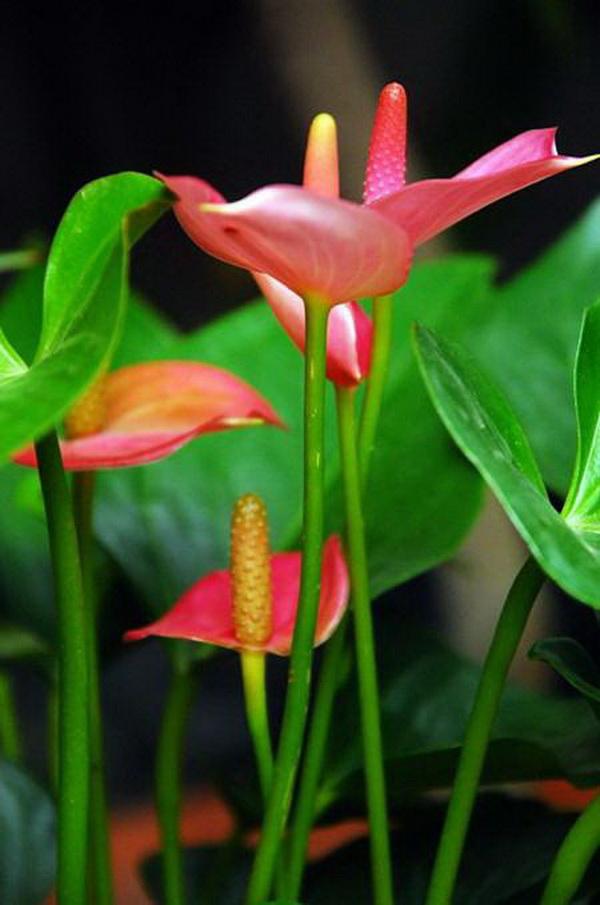
红掌,天南星科多年生常绿草本植物。茎节短;叶自基部生出,绿色,革质,全缘,长圆状心形或卵心形。叶柄细长,佛焰苞平出,卵心形,革质并有蜡质光泽,橙红色或猩红色;肉穗花序长5-7厘米,黄色,可常年开花不断。
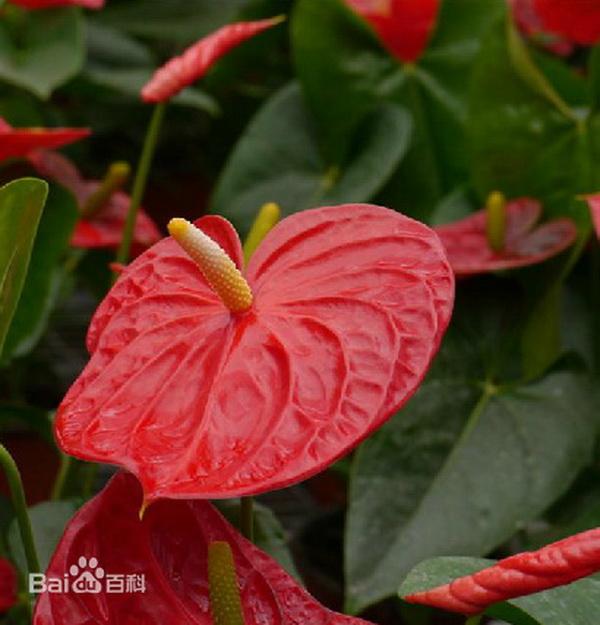
红掌是否有毒
红掌的花有轻微的毒性,只要不误食就不会有事,另外,红掌的毒性主要是存在于它的汁液里面,所以,在修剪红掌的时候一定要带上手套,并且在修剪之后洗手。
红掌误食或者是误触之后怎么办
如果误食红掌的话,可是非常难受的一件事情呢,嘴里又烧又痛,然后会肿胀起泡。嗓音变得嘶哑难听,吞咽也变得越发困难起来。多数症状会随着时间过去而减轻直到消失,如果想减轻痛苦,小编建议大家选择清凉的液体、止痛的药丸或者甘草类和亚麻仁的食物来进行吞服。
如果皮肤直接接触红掌的汁液,皮肤上会有烧灼感,慢慢变得红肿,不过不用担心,慢慢会好的,日常护理中只要不接触它的汁液就没事。
红掌的作用
红掌能够吸收空气中对人体有害的苯、三氯乙烯,净化空气,再加上红掌的花期较长,盆栽的单花期更是能够达到4~6个月之久!是非常适合的室内观赏花卉。
并且红掌也是非常合适的搭配室内陈设的一种植物,很容易制造出一种极佳的家居风格。
红掌适合摆放在卧室吗
如果是纯粹的观赏是可以放在卧室内的,和卧室内的家具相互映衬搭配,也可以为卧室添上一抹绿色,但是实际上,小编是不建议大家将植物摆放在卧室的,首先的一点,就是植物会在晚上的时候吸收氧气,排出二氧化碳。
当然,如果花友不嫌弃麻烦的话,可以在晚上的时候将花卉从卧室中拿出来,白天的时候再搬回去。
1
0


